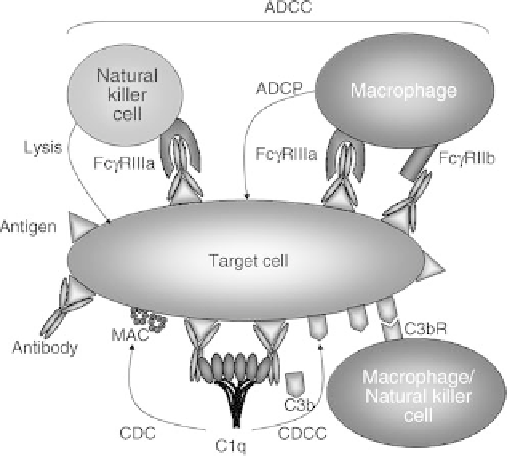Biomedical Engineering Reference
In-Depth Information
which are also present on macrophages, thus allowing a fine-
tuning of ADCP/ADCC reactions. ADCP is primarily
dependent on Fc
g
RIIa, but Fc
g
RIIIa and Fc
g
RI seem to
be involved as well [91]. Recently, it could be demonstrated
that three tandem repeats of Fc domains induced ADCP five
times more efficiently than the original antibody [92]. The
aforementioned Fc domain double mutant S239D/I332E
also had a 10-fold better binding to Fc
g
RIIa and conse-
quently a much better ADCP activity [93].
17.6.3 Complement-Dependent Cytotoxcitiy (CDC)
Complement-dependent cytotoxcitiy is mediated through
the interaction of the CH2 constant region of antibodies
with the C1q complement factor, which consists of six
heterotrimeric subunits. This triggers a proteolytic cascade
which induces the generation of a membrane-attack com-
plex (MAC), which represents a transmembrane channel
composed of a complex of C5b, C6, C7, C8, and C9 proteins
[94]. Since 10 times more surface bound antibody is required
to trigger the classical complement pathway than for ADCC,
only in rare cases a CDC reaction can be observed. Origi-
nally, CDC serves as pathogen defense mechanism because
it can be regulated by complement regulatory proteins that
are only present on human cells. In some cases, multiple
mutations in the Fc region could dramatically improve CDC
activity up to a factor of 600 [95].
Enbrel, a Fc fusion protein of the receptor-trap type, binds
both soluble and transmembrane tumor necrosis factor
a
(TNF-
a
). Although it contains a normal CH2 constant
region, only a very low CDC activity was found. This might
be caused by the absence of the CH1 region in Enbrel, which
is required for C3 binding and activation of subsequent
complement components [96].
FIGURE 17.4
Fc-mediated cell killing. An antibody bound to its
respective antigen on the surface of a target cell can induce
antibody-dependent cellular cytotoxicity (ADCC) through the
Fc
g
RIIIa on natural killer cells or antibody-dependent cell medi-
ated phagocytosis (ADCP) by macrophages that contain the
Fc
g
RIIa as well. Complement-dependent cytotoxicity (CDC) is
caused by the interaction of C1q complement factor with the CH2
constant region of the antibody, which induces the formation of a
membrane-attack complex (MAC) that lyses the cell. Alternatively,
C3b that is generated during this cascade facilitates phagocytosis
and cytolysis by labeling the cell as opsonin and interacting with
the C3b receptor (C3bR) on a macrophage or natural killer cell.
This reaction is called complement-dependent cell-mediated cyto-
toxicity (CDCC).
Fc
g
RIIIa [86]. Alternatively, binding to Fc
g
RIIIa can be
enhanced by a lack of fucosylation at amino acid 297. It
could be shown that the affinity to Fc
g
RIIIa beyond a certain
threshold irrespective of the optimization method will not
further improve ADCC effects [87]. This was also verified
for scFv-Fc fusion proteins undergoing Fc mutagenesis or
glycoengineering, or both [88].
Fc fusion proteins could benefit from improved effector
functions as well. Duplications of the Fc region were used to
increase ADCC of best-understood candidate, Enbrel
1
.
These tandem Fc repeats increased ADCC and CDC
10-fold and threefold [89]. A nonfucosylated variant of
Amevive
1
had 100-fold improved ADCC activity [90].
17.6.4 Complement-Dependent Cell-Mediated
Cytotoxicity (CDCC)
Alternative to the generation of MAC, decorating the cell
surface of the target cell with C3b as opsonin can cause cell
killing. This is mediated by the interaction of C3b with its
corresponding receptor (C3bR) on macrophages or NK cells
that facilitates cytolysis and phagocytosis. This process is
called complement-dependent cell-mediated cytotoxicity
(CDCC). Besides C3, the chemo-attractant C5a is also
involved in destroying labeled cells by facilitating an inflam-
matory response [97].
17.6.2 Antibody-Dependent Cell-Mediated
Phagocytosis (ADCP)
17.7 PEPTIDE-BASED TOXICITY
Since the Fc
g
RIIIa is found on macrophages too, antibody
decorated cells can also be eliminated by phagocytosis. This
process, also called antibody-dependent cell-mediated
phagocytosis (ADCP), can be blocked through Fc
g
RIIb,
Many of the aforementioned strategies rely on a combina-
tion of large targeting molecules such as antibodies with
other large molecules exerting the toxic activity. Despite the

Search WWH ::

Custom Search